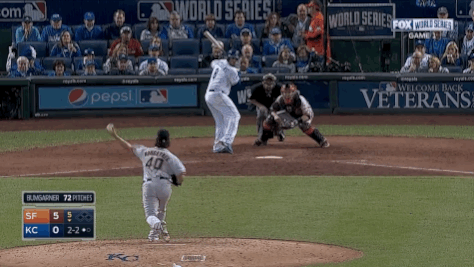Madison Bumgarner’s New Weapon
Throughout the playoffs, many of us baseball analyst type have spilled some pixels with regards to Madison Bumgarner’s fastball, because Madison Bumgarner’s fastball is great. It’s the main thing he used to pitch to the tune of a 2.98 ERA and 3.05 FIP this year, it’s the main thing he used to throw all those scoreless playoff innings you keep hearing about, and it’s the main thing he used last night to get the Giants one step closer to winning their third World Series championship in five years.
There are so many little, minute things about baseball that keep me endlessly fascinated. One of them is when a situation appears to be unbeatable. Think Mariano Rivera cutter. Think Miguel Cabrera hitting 0-2 pitches out of the zone for homers during his 2012 or 2013 seasons. Think Barry Bonds. Baseball is already a game of failure, and I just love when things get ramped up a notch from “I’m probably going to fail,” to, “I have no choice but to fail.”
Another one of those little, minute things that fascinate me is a slow curve. I wrote a whole post about them a couple months back, and now I’m writing another one. But more specifically than just the slow curve: the slow curve after a hard fastball. An isolated slow curve is neat. A slow curve after a series of fastballs starts to push into the “unbeatable” territory from above.
So, Madison Bumgarner’s got this great fastball, and now he’s got this other thing:
Bumgarner’s always had a fastball (duh) and he’s always had a curveball. For four years, he had that one normal curveball that went about 77mph. Now, he’s got a different, slower curveball that goes 67mph. This isn’t just taking a couple ticks off the standard curve, this is an entirely different pitch.
It made its debut in June and didn’t make any appearances in July. Since then, Bumgarner’s been going to it more and more. He’s thrown just 21 slow curves, so it’s not like this is some major repertoire change, and the slow curve is simply a fraction of a fraction of what makes Bumgarner so good. But it’s an extra little wrinkle, and each extra little wrinkle is advantage: Bumgarner.
But what’s more interesting than the fact that Bumgarner added this little weapon is how he’s decided to use it. Using the BaseballSavant PITCHf/x search, I was able to identify 378 instances from this season of a pitcher throwing a slow curve that differed from their regular curve (guys like Jered Weaver don’t count here, as all of his curves are “slow curves”).
Out of those 378 curves, 21 were thrown by Bumgarner, which leaves us with 357 non-Bumgarner slow curves. Of those 357, just 99 were thrown in two-strike counts. That’s a rate of just 28%. For most guys, the slow curve isn’t a put-away pitch. More often that not, it’s probably a first-pitch offering to steal a strike without letting a hitter see what you’ve really got.
Looking just at Bumgarner’s 21 slow curves, 17 of them were thrown with two strikes. That’s a rate of 81% percent. Bumgarner views his slow curve as a legitimate weapon, rather than a gimmick pitch like the rest of the league.
* * * * *
Let’s run through a quick sequence of five pitches Bumgarner threw to Mike Moustakas in the fifth inning of last night’s game to get an idea of how Bumgarner uses his new weapon:
There’s a four-seam fastball at 92mph, right down the middle for strike one.
There’s a four-seam fastball at 92mph, a little off the plate for ball one.
There’s an 87mph cut fastball that catches the outside of the plate for strike two.
There’s a 93mph fastball way outside, trying to get Moustakas to chase for strike three.
And then, after four pitches of 92, 92, 87 and 93, we’ve got a 67mph curveball for a swinging strike three.
* * * * *
A lot of guys rely on their breaking pitches when they get to two strikes. Not Bumgarner. When Bumgarner has two strikes on a batter, he goes to one of his two fastballs 80% of the time. Generally speaking, hitters have to expect a pitch in the 90’s when they fall behind against Bumgarner. Sometimes, they’ve had to worry about him flipping a 77mph curveball. Now, there’s a little part of them that has to worry about a 67mph curveball, too. In Moustakas’ case, that was a 26mph drop from the most recent pitch he had seen, and now we’re full into the “unfair, unbeatable” category.
Again, this is one pitch for one strikeout from last night’s game, and he only threw two slow curves all night. This is such a small part of Bumgarner’s game. But that’s kind of the whole point of the slow curve. Throw it too often and it loses its effectiveness. The magic of a pitch like this is that the hitters know it’s in there, but they can never actually expect it. Madison Bumgarner is still who he is because of his fastball and his cutter. He’s still who he is because of his arm slot, and he’s still who he is because he’s a workhorse. For these reasons, he was already one of the game’s best pitchers long before he learned a new trick. And, really, his new trick is more of a weapon than it is a trick.
August used to cover the Indians for MLB and ohio.com, but now he's here and thinks writing these in the third person is weird. So you can reach me on Twitter @AugustFG_ or e-mail at august.fagerstrom@fangraphs.com.






First thing I thought when I saw that pitch was that the Royals had no chance. Sure enough, they had no chance.